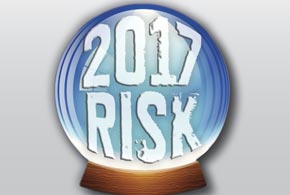
The Top Risks for Organizations in 2017
 The Top Risks for Organizations in 2017
The Top Risks for Organizations in 2017
Corporate board members and executive leaders are concerned about economic conditions, regulatory changes and scrutiny, disruptive technology and cyber-attacks and threats.
 Economic Uncertainty
Economic Uncertainty
72% of the board members and executives surveyed are concerned that economic conditions in the markets they serve may restrict growth opportunities.
 Ominous Oversight
Ominous Oversight
66% cited prospects for heightened regulatory changes and scrutiny as a top risk, because they can affect the manner in which products and services are delivered.
 Passing Lane
Passing Lane
63% are concerned that the rapid speed of disruptive innovations and/or new tech in their industry may outpace their company’s ability to compete and/or manage risk, without making major changes to the business model.
 Destructive Force
Destructive Force
60% of the respondents fear that their organization may not be sufficiently prepared to manage cyber-threats that can significantly disrupt core operations and damage their brand.
 Protection Plan
Protection Plan
57% cited the need to ensure privacy, identity management, information security and system protection as a top risk, as these measures may require vast resources.
 Market Shift
Market Shift
57% admitted that sustaining customer loyalty and retention may be increasingly difficult due to evolving consumer preferences and demographic shifts in their existing customer base.
 Talent Targets
Talent Targets
55% of the respondents are concerned that their company’s succession challenges and ability to attract and retain top talent may limit the achievement of operational targets.
 Avoidance Environment
Avoidance Environment
55% fear their organization’s culture may not encourage the timely identification of risk issues that have the potential to affect core operations and the accomplishment of strategic objectives.
 Inflexible Position
Inflexible Position
54% of the respondents said resistance to change may restrict their company from making necessary adjustments to the business model and core operations.
 Topsy-Turvy
Topsy-Turvy
53% of the corporate board members and executives cited anticipated volatility in global financial markets and currencies as a significant risk.